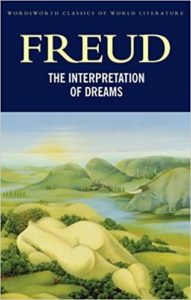‘To sleep, perchance to dream…’ is a Shakespearean line that everybody seems to know. But what is behind the dreams that sometimes haunt you after you wake up? Dr Freud has answers
Well, it started in Vienna not so many years ago
When not enough folks were getting sick
That a starving young physician tried to better his position
By discovering what made his patients tick
He forgot about sclerosis and invented the psychosis
And a hundred ways that sex could be enjoyed
He adopted as his credo “down repression up libido!”
And that was the start of Doctor Sigmund Freud
Well, Doctor Freud (Doctor Freud), oh Doctor Freud (Doctor Freud)
How we wish you had been differently employed
But the set of circumstances still enhances the finances
Of the followers of Doctor Sigmund Freud
Well, he analyzed the dreams of the teens and libertines
Substituted monologue for pills
He drew crowds just like Will Sadler, when along came Jung and Adler
And they said by God, there’s gold in them darn’ ills…
— Chad Mitchell Trio
This ballad, popular in the 1970s when Freudian psychoanalysis became the rage in the West (but never in India), is a rueful take on the whole shrink business and suggests his theories were basically a way of making money. But while many of his methods and conclusions were overtaken by other fads, two things stood the test of time: the notion that most behavioural problems can be traced back to childhood experiences and his seminal work on interpretation of dreams, especially the fact that they have their origin in sexual repression.
Half of our dreams, he says, (interpreting him loosely) take root in anxieties, like the recurring dreams we often have of missing a bus or train, or being dragged back when trying to accomplish a task. The other dreams are a means of wish fulfilment, even the unpleasant ones.
There are some symbols which occur in a lot of dreams, and they can be seen as indicating the genitals. In The Interpretation of Dreams he writes, “In men’s dreams, a necktie often appears as a symbol for the penis. No doubt this is not only because neckties are long, dependent objects and peculiar to men, but also because they can be chosen according to taste – a liberty which, in the case of the object symbolized, is forbidden by Nature. Men who make use of this symbol in dreams are often very extravagant in ties in real life and own whole collections of them.” So what do we make of men who are constantly stroking or fingering their ties? Freud doesn’t say.

Now that this line of thinking is clear, it is no surprise that reptiles like snakes and lizards are suspect. The latter, because of its ability to lose its tail and then regrow it, is condemned forever to be a phallic symbol. All elongated symbols, such as “sticks, tree trunks and umbrellas (the opening of the last being comparable to an erection)” if they appear in dreams, point towards frustration of the sexual kind. So do nail files, because of the rhythmic motion in which they are usually applied. Interestingly, if you see dreams in which you are going up or down stairs, this is clearly a symbol of coitus, especially because both are rhythmic activities.
As Freud’s relentless search for sexual symbols continues, he predictably theorises: “Nor is there any doubt that all weapons and tools are used as symbols for the male organ: e.g. ploughs, hammers, rifles, revolvers, daggers, sabres, etc.”
If you dream of beautiful landscapes, as city-dwellers fed up of concrete jungles do, you are not off the hook. “In the same way many landscapes in dreams, especially containing bridges or wooded hills, may clearly be recognised as descriptions of the genitals.”
So much for male symbols. How do women appear in dreams where the symbolism is not so obvious, and needs a psychoanalyst to draw parallels? “Boxes, cases, chests, cupboards and ovens represent the uterus, and also hollow objects, ships and vessels of all kinds. Rooms in dreams are usually women, if the various ways in and out of them are represented, this representation is scarcely open to doubt.”
The raw material from which Freud, as also his fellow psychiatrists like W Stekel and Carl Jung, extracted and processed their theories were actual dreams, their own and those of their patients and family members. The effort is to find out what is in the sub-conscious, and relate it to what is happening in the patient’s life. What kind of dreams are these? Let us see:
A young lady who had just been engaged to be married, but could foresee some trouble ahead said this: “I arrange the centre of a table with flowers for a birthday.” She thinks the setting is her home and she feels happy while doing so. When asked what flowers they were, she answered, “Expensive flowers, one has to pay for them. Lilies of the valley, violets and pinks or carnations.” Freud felt the way she described the cost of flowers meant that she hoped her fiancé would appreciate the value of virginity, lilies depicted chastity, she herself thought violets were associated with ‘violate’ and carnations were association with ‘incarnation’. So the dream meant, in short, that “she was making a gift of her virginity and expected in return a full and emotional sexual life for it,” at the same worrying about the physical pain the consummation of the marriage would bring. The patient was obviously not aware of these suppressed thoughts and were only revealed by the dream.
Imagine what fun he had with the following dream of a woman who self-confessedly feared seduction:
“I was walking in the street in the summer, wearing straw hat of peculiar shape; its middle-piece was bent upwards and its side-pieces hung downwards in such a way that one side was lower than the other.” Under sustained interrogation (what else can one call it?) she admitted to wondering whether such asymmetry was normal in men.
Reassuringly, Freud concludes that dreams do not disturb your sleep but prolong it, they are guardians of sleep. This seems to be validated by the experience of those who dream after waking up too early in the morning, for the sounds made by others in the household get incorporated into our dreams. All of us dream, but we may not necessarily remember the dream in the morning. If they are helping us with wish fulfilment, well and good – especially if you are hitting the sack with someone whom it would not be appropriate to proposition in real life. But if your dreams are increasing your anxiety, maybe it’s time to see a shrink.





